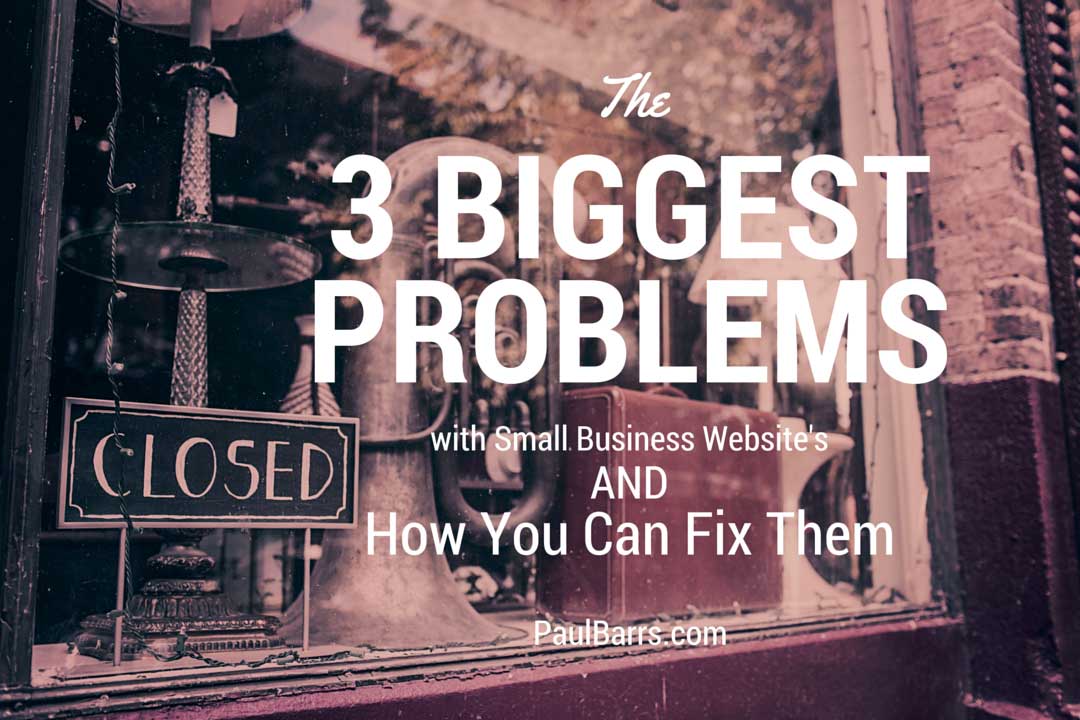
25 Jul The 3 Biggest Problems with Small Business Websites (and How You Can Fix Them)
Want to know what the most common problems with small business websites are? How about how to fix them. Here’s the answer!
Let’s talk about the 3 biggest problems with small business websites and how you can easily fix them.
Hi there, my name is Paul Barrs. Hello and welcome. Thank you so much for taking the time to stop by and join with me. I work with small businesses each day every day for the last 15 years. I’ve been working with small businesses, helping them to improve their websites. And I’ve come across a number of things that if I were to say they were common factors – this would be it. And these are things that you can actually do to take care of yourself if you’re a small business owner.
Number 1- Your website probably isn’t being updated often enough, alright? Now maybe you are one of the rare few, indeed would be rare.
People often say to me “Paul, how often should I be updating on the content on my website?”
My answer is simple, as often as you can.
Now true, we must serve our paying customers first, that is a golden rule. No point in, you know, messing up things that are already working well. But if you want to build your business, if you want to grow your business, you’re going to need to take a step out further. And your website is a primary portal for that.
Search engines love new content. Consumers love new content. People ready to buy, they love new content. They want to see that you are active in your business. Not answering the phone but also with updating your website, keeping that content fresh.
Number 2– The page structure or the on-page navigation points. They’re too hap-hazard; they’re not focused well enough. Now, I’m not just talking about the menus across the top. No, every website these days particularly with a CMS seems to get that right. I’m talking about the structure of the pages. Your-website.com.au/blog/blah …blah… Your-website.com.au/shop/blah…blah…
Should we be using categories? Should we be using tags? Well, yes. There’s absolutely nothing wrong with using a category within the URL but don’t repeat it in the page name. So things within the blog /blog, things within the shop /shop, absolutely let people know who are searching that when that result come up in search they’re going directly to the shop.
So here’s the thing, when it comes to people seeing your results in search, Google will structure them according to what the user has actually searched at this point of time. Therefore you need to structure your URL’s in the same way. And by the same token, your on-page navigation, not the menu bar across the top, but the links from within one page to another page, too hap-hazard. You need to identify your primary conversions pages and direct traffic from all over to them. Because they are the ones that sell people on both products, service but also you.
Number 3- Your website pages they don’t, they don’t share well. They can’t be found in search. They cannot contain too many errors. I know 3 things, well there’s three things just on their own.
Let’s go through them one at a time but I have to squeeze these in… When your web pages don’t share well, have you ever noticed you create a new page and you share it to say, Facebook for example, and the graphic, the image you want doesn’t come up with it? How annoying is that?
Well just simply Google something, or go to Facebook developers and look for the Facebook debugger and there you get to find out exactly what it is on your page that is bringing up this image or none over that one. And play around with that little bit and make some adjustments or of course if you’re not technically minded get someone technically minded to do it, because the way that your pages share in Social Media are vitally important, a good headline, a good description, a good image if it’s available, vitally important for bringing other people back to your website.
Also you can’t be found in search and this isn’t quite the same thing but it is a technical thing. It surprised me a few years ago when going through some Google training; I saw that for them the number one thing, the number one reason why websites weren’t ranking well wasn’t because of their content, it was because they couldn’t even be found by Google. They had that thing with usually the robots.txt file which blocked Google and if you got a new website or you just done some redevelopment, this is something you need to do.
You absolutely must register and verify your website with Google Web Master Tools, submit your XML Sitemap and get Google to crawl, to fetch your website to make sure there aren’t any errors. And finally that was the last in the list, errors, errors, errors, not just technical errors, on-page errors, 404 pages missing errors, image errors, missing, gone all sorts of problems. And I’m saying to you now that if you have a moderate, small, maybe a recent website, these are things you can easily fix yourself.
My website now is over 600 pages, because I’ve been running it for 15 years and I’ve got lots of content that is being updated over that time. But even I need to go through from time to time and look at these things and fix them. You need to do the same, because these are the three biggest problems with small business websites, things that you can fix. They’re not updated often enough, the page structure and sales funnel links from page to page are usually hack hazard and they don’t share well, they don’t come up well in search and they have too many errors, simple things to fix with a little time, a little care and little consideration.
My name is Paul Barrs from PaulBarrs.com. Thank you so much for joining with me and I’ll talk to you again next week. Bye-Bye.


